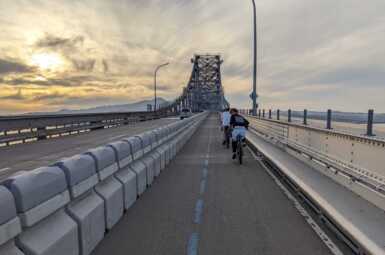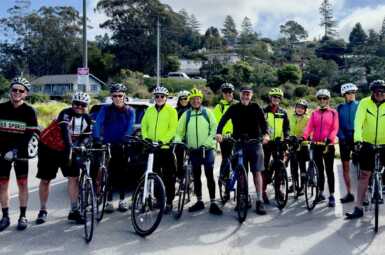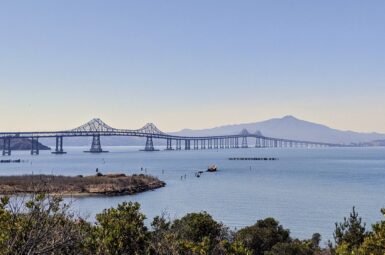June 2022 Election 2022 District 5 Supervisor Candidate Questionnaires
As a 501(c)3 nonprofit organization, Marin County Bicycle Coalition cannot endorse candidates for public office, but we are able to share information so that you can arrive at your own conclusion. Below are the 2022 District 5 Board of Supervisor candidates’ responses to our questionnaire on bicycling in Marin (click here to see a map of the district). We have made no content changes. Thanks to the candidates for their time and thoughtful answers.
Here are the candidates on the June ballot for District 1 Board of Supervisors:
-
Jason Sarris
Personal Travel
1. Do you ride a bicycle? If so, for what purposes and how often? (transportation/road/mtb)
Eric Lucan:
-
a. Commuting: couple of times per month
-
b. Errands: couple of times per month
-
c. Road recreational: couple of times per month
-
d. Mountain biking or trails: handful of times per year, although I am leading an advocacy ride at Ales & Trails this Saturday
Colin Medalie:
No response
Kevin Morrison:
-
a. Commuting:
-
b. Errands:
-
c. Road recreational:
-
d. Mountain biking or trails:
I ride about once a week, mostly road recreation plus some easy trails.
Jason Sarris:
No response
2. If you own a bike, what type of bike(s) do you have and ride? If not, when was the last time you rode a bike, and where (on vacation, for example)?
Eric Lucan:
I last rode a bike this past weekend. I have been door-to-door canvassing for the campaign by bike as it is the best way to cover a lot of ground.
I currently only own one bike, a PUBLIC V7 with a child seat for my 3 year old. With two kids now, most of my riding is limited. I have previously owned a couple of Specialized Roubaix road bikes and used to do more road riding.
Colin Medalie: No response
Kevin Morrison:
My bike is a 22-year-old Schwinn s[9five].3 and it still rocks!
Jason Sarris: No response
Vision
3. In your own words, describe your vision for the future of transportation in District 1 and Marin County at large.
Eric Lucan:
Simply put, my vision is one where single occupancy car trips are no longer the default or preferred method of transportation.
Colin Medalie: No response
Kevin Morrison:
“Strong and content, I travel the open road.”
So wrote Walt Whitman, that most American of poets, more than a century ago.
Americans have always cherished mobility. We see the freedom of the open road as part of the American dream.
That said, today we’re also fighting climate change. We’re weaning ourselves off fossil fuels. We see green change is necessary, although full of challenges.
But we are meeting the challenges! Ordinary people are dropping gas cars and driving electric vehicles. They’re biking more, walking more, and thinking about public transportation more often.
It isn’t hyperbole to say that the transition to more bikes, more walking, and more EVs is already on track to be the greatest personal change of the 21st century. That’s true because:
-
Governments are playing a role. California, in particular, has helped enable tens of thousands to see the benefits of biking and walking..
-
Nonprofit groups are playing an especially important role. They provide support, education, and motivation for people to make the transition. You and MCBC are doing a great job.
Inexplicably, Marin County isn’t among the leaders in emphasizing this transition. To correct that, I will expand opportunities for safe biking and walking, which are largely ignored by current County efforts, in order to triple the number of trips made by bike and double the number of walking trips by the end of this decade.
Jason Sarris: No response
Traffic
A large proportion of peak hour traffic is made of people driving their children to school. While some people live too far to easily walk or bike to school, many parents are simply afraid to let their children travel by foot or by bicycle because of the high volume and speeds of car traffic.
4. What strategies would make more parents feel safe with their children walking or biking to school, thereby reducing traffic and making everyone else’s trip to school a little safer?
Eric Lucan:
Through my work as a long-time board member and past chair for the Transportation Authority of Marin, I have focused on 3 key areas in collaboration with Safe Routes for School:
-
Infrastructure – the built environment plays a critical role in making it safer to walk, bike, or roll to school. We must prioritize and fund safe pathway projects and multi-modal options instead of car centric projects.
-
Crossing Guards – we expanded crossing guards and need to continue to fund these positions moving forward.
-
Education – I have advanced school specific vicinity maps that are used to educate parents and the school community on what percentage of their student body lives within ¼ mile, ½ mile, 1 mile, etc from their school. These maps are a great tool on where to focus efforts to change behavior.
Colin Medalie: No response
Kevin Morrison:
We have prioritized car speed and motorist convenience over bicyclist and pedestrian safety. We must prioritize safety over speed and convenience. It’s pretty simple.
Jason Sarris: No response
A survey from the Transportation Authority of Marin (Figure 18, p. 51) found that over half of Marinites would like to bike more than they currently do. This backs up research that shows that over 50% of adults are interested in biking, but concerned about the threat of fast-moving cars.
5. What concrete steps can be taken to allay these concerns and make people feel safe on bicycles?
Eric Lucan:
We need to continue to invest in Class I and Class IV paths for both new and existing infrastructure. Separated or protected paths are the best solution for advancing biking.
Colin Medalie: No response
Kevin Morrison:
More bike lanes, more pedestrian options, and more well-designed multi-use paths will go a long way to getting more people out of cars and onto bikes. Underwriting public outreach – MCBC’s outreach is a great example – will also go a long way to accomplishing this goal.
Jason Sarris: No response
Safety
Traffic deaths and injuries are on the rise, both nationally and in Marin (this includes all road users, not just bicyclists). The Marin County Department of Public Works has recently adopted a Vision Zero policy setting an explicit goal to eliminate traffic deaths on County-owned roads.
However, there are often challenges in the implementation of such plans, with projects that would improve safety for all road users potentially resulting in more congestion or decreasing drivers’ top speeds (a fear expressed in the Point San Pedro Road pilot project).
6. Do you see safety as the highest priority for the transportation system? Or should it sometimes be secondary to traditional metrics like congestion and delay?
Eric Lucan:
Safety is the highest priority for any transportation system.
Colin Medalie: No response
Kevin Morrison:
Yes, safety must be the highest priority in our transportation system. We have a deeply flawed way of characterizing safe speeds for vehicles, using data to determine the “85th percentile” speed of vehicles and working from there. Recently, that system led the City of Novato to increase speeds on roads which have already experienced higher levels of death and injury. Kinda nuts, right? Novato also has a statutory minimum speed. Even if a road is dangerous, the marked speed limit can’t be below 25. Also kinda nuts.
Jason Sarris: No response
Climate Change
The latest IPCC report states clearly that greenhouse gas emissions need to be reduced quickly in order to stave off the worst effects of climate change. According to Marin County’s most recent Greenhouse Gas Inventory, transportation accounts for a large share (31%) of local greenhouse gas emissions. Given that battery electric cars make up 3% of California’s vehicle fleet, and only 12% of new cars sold,
7. does reducing overall driving have a role in meeting our climate targets? If so, what policies can support transit, walking, and bicycling in place of driving for short trips?
Eric Lucan:
Reducing overall driving plays a significant role in reaching our climate targets and reducing Greenhouse Gas Emissions. We know from studies that 24% of trips in Marin are 2 miles or less. We have the weather and climate to support year-round walking and bicycling, but we are lacking on the infrastructure. In addition to prioritizing transit, walking, and biking, we also need to ensure that new housing is connected to this infrastructure.
Colin Medalie: No response
Kevin Morrison:
Yes, reducing overall driving must have a role in our future. Heck, it’s gotta have a role now, not tomorrow. Ebikes will play a big role in getting Marinites out of cars. The excuses about not being in shape, not wanting to get sweaty – whatever keeps people from biking – don’t apply to ebikes. And the more ebikes we get on the road, the more bikes of all kinds will gain access and acceptance in our customary transportation decisions.
Jason Sarris: No response
Project Delivery
Bicycle/pedestrian plan implementation is notoriously slow with typically fewer than one new bike lane project opening every year.
8. What steps would you take to hasten the project delivery process from inception to ribbon-cutting?
Eric Lucan:
Given the amount of state and federal funds that are available and becoming available for bicycle and pedestrian infrastructure, it is critical that we use the limited local funds we have to get projects “shovel-ready”. As a SMART board member, I worked to allocate $10.8M towards permitting, environmental, and 30% design for remaining segments of the multiuse path with $6M of that total amount going directly to Novato / District 5. While the multiuse path has progressed slower than anyone would have liked, this allocation was a monumental step in the right direction to close the gaps.
Colin Medalie: No response
Kevin Morrison:
Marin County’s opaque decision-making processes and super-slow committee-after-committee considerations don’t serve anyone’s interests. I will introduce new metrics in County to reward baseline progress on all new projects. Instead of being rewarded for showing up, county employees will be rewarded for pushing forward with their work on a pace that serves the public.
Jason Sarris: No response
In all things, there is a tension between “perfect but slow” and “fast and good enough.” Recent years have seen a move toward so-called “quick-build” infrastructure, allowing reconfiguration of streets to facilitate safer walking/biking without a years-long engineering process. While quick-build projects may be less aesthetically pleasing than the standard process, they are cheaper and happen much faster.
9. How do you rank aesthetic concerns of biking/waking infrastructure in comparison to those of cost and project speed?
Eric Lucan:
I believe we should be pursuing additional quick-build projects regardless of aesthetics and in many ways, it can be a positive to the community. On the reverse side, I have heard negative comments about some of the most aesthetically designed bike projects as they are often viewed as too expensive or not a good use of taxpayer dollars based on usage. With that in mind, quick-build projects can often be put out as a pilot and then enhanced aesthetically over time. The perception of these projects is always in the eye of the beholder. Bike and pedestrian projects should meet the needs of the users, not the aesthetic eye of those driving alongside it. However, safety should never be sacrificed in any circumstance.
Colin Medalie: No response
Kevin Morrison:
All new biking/walking infrastructure is beautiful when you’re on your bike or walking around. The migration to biking/walking/transit must be faster. Our quality of life depends on it.
Jason Sarris: No response
Parking
Much of Marin has narrow streets, but on-street parking typically takes up between 30-40% of the street space between the curbs, and is often in tension with the need for dedicated bike lanes.
10. In your mind, are bike lanes ever sufficiently important to justify removing on-street parking, and in what circumstances would you consider that to be the case?
Eric Lucan:
This usually comes down to a case-by-case evaluation. On Vineyard Road in Novato, we recently completed a project that resulted in the removal of some parking spaces to make room for Class II bike lanes. This was near a school and also in a neighborhood of single-family homes and garages. We worked closely with the residents for a great outcome.
I do support complete streets and generally support bike lanes over on-street parking. In existing neighborhoods though, it takes a lot of community outreach and work with residents when replacing existing spaces with new bike lines. I have found a collaborative approach to be the best solution.
Colin Medalie: No response
Kevin Morrison:
I live in downtown Novato where on-street parking is a hazard for all of us who bike and walk. Our streets were designed for moving vehicles, bikes, and pedestrians. Parking should be off-street, preferably under a solar canopy. Creating parking will create green jobs and improve our overall quality of life. Nothing is stopping us except lack of leadership.
Jason Sarris: No response
Wrap-up
11. Why should people who ride bikes (or those who want to ride bikes but don’t yet) vote for you?
Eric Lucan:
Why should you vote for me? Let’s go for a ride together and chat. I ride bikes, I work in the bike industry (Chief Marketing Officer for Mike’s Bikes since 2014), and I am an advocate for multi-modal transportation and biking. I encourage you to visit my site at ericlucan.com to learn more about my campaign. See you on the paths and trails!
Colin Medalie: No response
Kevin Morrison:
I’m not a conventional politician. I haven’t spent years currying favor with conservative, status quo groups. I haven’t made compromises about ethics, and I won’t make compromises about ethics, and as a result I will never be investigated by the State of California for corruption.
I value principles over politics. I value people and planet over enriching myself and my cronies.
The ancient Greeks put it this way: “A society grows great when old people plant trees in whose shade they will never sit.”
Jason Sarris: No response
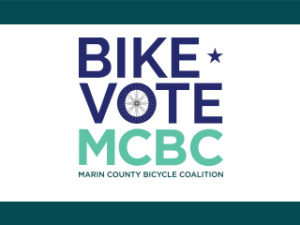
members make it happen!
We’re fighting for a more bike-friendly future in Marin. Are you with us? Join Marin County Bicycle Coalition today.
